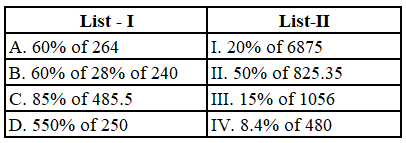JIPMAT 2025 Question Paper
For the following questions answer them individually
JIPMAT 2025 - Question 11
In 4 years, an amount of ₹ 6,000 becomes ₹ 8,000 at a certain rate of simple interest. In what time at the same simple interest rate, will an amount of ₹ 525 become ₹ 700?
JIPMAT 2025 - Question 12
After adding 5 to both numerator and denominator of the following fractions, arrange them in ascending order of the magnitude of change in their values.
A. $$\frac{2}{3}$$
B. $$\frac{3}{4}$$
C. $$\frac{4}{5}$$
D. $$\frac{5}{6}$$
JIPMAT 2025 - Question 13
Selling price of a glass is ₹ 1,965 and loss percent is 25%. If its selling price is ₹ 3,013, then what will be profit percent?
JIPMAT 2025 - Question 14
Consider the following statements, which of them is/are correct?
A. If the height of cylinder is doubled, the area of curved surface is doubled.
B. If the radius of a hemispherical solid is doubled, its total surface area becomes fourfold.
C. If a hemisphere and cone have equal bases and equal heights, then the ratio of curved surface area is $$\sqrt{2}:1$$.
JIPMAT 2025 - Question 15
$$\frac{(4.53-3.07)^{2}}{(3.07-2.15)(2.15-4.53)}+\frac{(3.07-2.15)^{2}}{(2.15-4.53)(4.53-3.07)}+\frac{(2.15-4.53)^{2}}{(4.53-3.07)(3.07-2.15)}$$ is simplified to
JIPMAT 2025 - Question 17
$$\sqrt{2+\sqrt{3}}\times\sqrt{2+\sqrt{2+\sqrt{3}}}\times\sqrt{2+\sqrt{2+\sqrt{2+\sqrt{3}}}}\times\sqrt{2-\sqrt{2+\sqrt{2+\sqrt{3}}}}$$ is equal to
JIPMAT 2025 - Question 18
The traffic lights at three different road crossings change after every 48 sec, 72 sec and 108 sec, respectively. They all change simultaneously at 08:20:00 hours, when will they again change simultaneously?
JIPMAT 2025 - Question 19
If $$x^{3}+y^{3}=468$$ and x+y=12, then value of $$x^{4}+y^{4}$$ will be
JIPMAT 2025 - Question 20
₹ 11,550 has to be divided between A, B and C such that A gets $$\frac{4}{5}$$ of what B gets and B gets $$\frac{2}{3}$$ of what C gets. How much more does C get in comparison to A (in ₹)?

